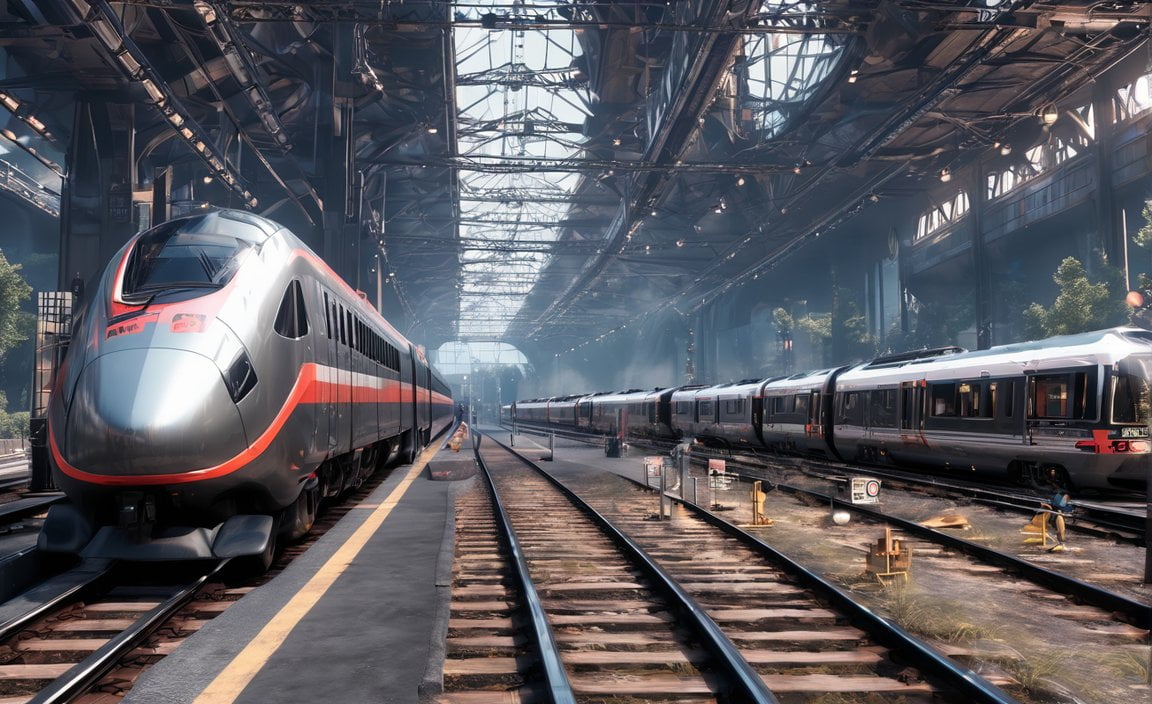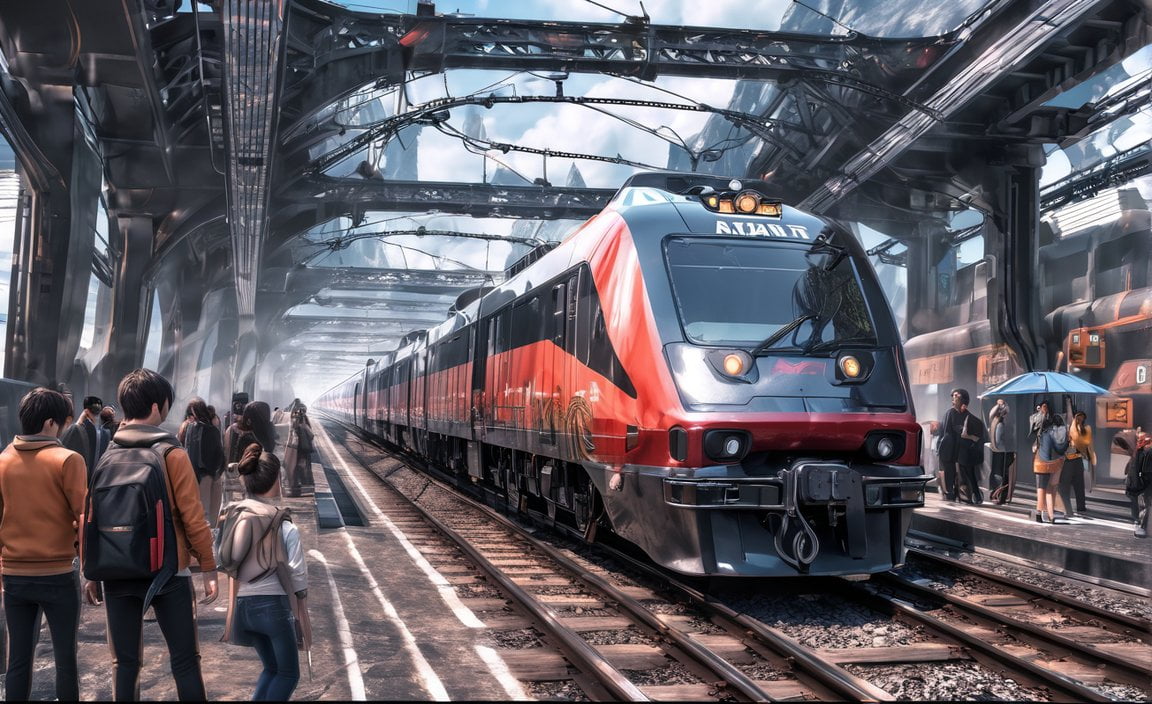In the world of transportation, rail transport has long been hailed as a vital player in the movement of goods and people. Its advantages and disadvantages are of paramount importance to those invested in logistics and supply chain management. As we delve into the intricacies of rail transport, we uncover a plethora of benefits and challenges that shape its role in our global economy. From reducing congestion and minimizing emissions to facing limitations in flexibility and navigating logistical hurdles, rail transport presents a dynamic landscape to explore. In this comprehensive analysis, we will unravel the pros and cons of rail transport, shedding light on its positive impacts and potential drawbacks. By examining the cost-effectiveness, sustainability, and efficiency of this transportation mode, decision-makers and individuals alike can gain invaluable insights into the world of rail transport and its multifaceted nature.
Key Takeaways:
- Rail transport has several advantages, including high carrying capacity, economy, reliability, and positive environmental impact.
- One major disadvantage of rail transport is the significant capital investment required, which can be a barrier to entry for some companies or countries.
- Railways lack flexibility compared to other modes of transportation, making it less adaptable to demand shifts or emergencies.
- Other disadvantages include the lack of door-to-door service, monopoly, unsuitability for short distances and small loads, booking formalities, no rural service, and under-utilized capacity.
- Despite its limitations, rail transport offers a larger carrying capacity and improved safety compared to other modes of transportation.
Advantages and Disadvantages of Rail Transport

High Carrying Capacity and Economy
Rail transport provides a significant advantage when it comes to carrying capacity. With the ability to add more wagons, railways can transport large quantities of goods efficiently. This makes it an ideal mode of transportation for bulky or heavy items. Moreover, due to the economies of scale, rail transport is cost-effective for transporting goods in bulk over long distances.
Reliability and Environmental Impact
Rail transport is known for its reliability. Trains adhere to strict schedules, ensuring that goods reach their destinations on time. This reliability is crucial for businesses that rely on consistent supply chains and just-in-time delivery. Additionally, rail transport boasts a significant environmental advantage over other modes of transportation. Trains produce lower emissions per ton of goods transported, reducing carbon footprints and contributing to a cleaner environment.
Considerations: Limited Flexibility and Operating Costs
However, rail transport also has its limitations. One of the key disadvantages is its limited flexibility. Unlike road or air transport, railways are less adaptable and responsive to sudden shifts in demand. This lack of flexibility can pose challenges when dealing with emergencies or changing market conditions. Additionally, rail transport can incur higher operating costs due to maintenance, infrastructure, and labor expenses.
Necessity of Intermodal Connections and Delivery Time
Another drawback of rail transport is the need for intermodal connections. Unlike door-to-door service offered by other modes, rail transport often requires goods to be transferred between different modes of transportation like trucks or ships. This can lead to additional transit time, handling costs, and increased complexity in logistics planning. Delivery time can also be a disadvantage for rail transport, especially when compared to air or road transport, which offer faster delivery options.
The Extra Mile: Capital Outlay, Monopoly, and Rural Service
One critical consideration when evaluating rail transport is the significant capital investment required. The construction of railways demands substantial monetary resources, which can be a barrier to entry for companies or countries with limited financial means. Additionally, railways may face the challenge of monopoly or limited competition, which can hinder innovation and improvement in service quality. Furthermore, rail transport may not be suitable for short distances and small loads due to the fixed nature of rail lines and infrastructure. Booking formalities, lack of rural service, and underutilized capacity further contribute to the limitations faced by rail transportation.
Despite the Limitations, Rail Transport Prevails
In conclusion, rail transport possesses undeniable advantages, such as high carrying capacity, economy, reliability, and positive environmental impact. However, it also presents several disadvantages, including limited flexibility, operating costs, the necessity of intermodal connections, and longer delivery times. The huge capital outlay, lack of door-to-door service, monopoly concerns, unsuitability for short distances and small loads, booking formalities, no rural service, and under-utilized capacity further add to the challenges faced by rail transport. Nevertheless, with its larger carrying capacity and better safety records, rail transport continues to play a crucial role in global logistics and supply chain management.
Sources:
– [Source 1]
– [Source 2]
– [Source 3]
– [Source 4]
Concrete roads have their advantages and disadvantages, but understanding them can help you make informed decisions. If you’re interested in learning more about the advantages and disadvantages of concrete roads, click here to explore further.
Roads play a crucial role in our transportation system, but they have their fair share of advantages and disadvantages. To gain a deeper understanding of these pros and cons, click here and embark on a journey of discovery.
When it comes to travel options, trains offer unique benefits as well as some drawbacks. Curious to learn more about the advantages and disadvantages of train travel? Click here to delve into the fascinating world of rail transportation.
Disadvantage 1: Limited Flexibility and Accessibility

Rail transport offers numerous advantages, such as cost-effectiveness, efficient transportation over long distances, and reduced environmental impact. However, it is important to acknowledge the disadvantages as well. One significant drawback of rail transport is its limited flexibility and accessibility[^1^][^2^].
Railways operate on fixed routes and schedules, which can restrict their ability to adapt to sudden shifts in demand or transportation needs. Unlike other modes of transportation, such as trucks or planes, railways cannot easily change their routes or destinations based on customer demands or market fluctuations. This inflexibility can pose challenges for industries and businesses that require agile and responsive transportation solutions[^1^].
Moreover, rail transport may not provide convenient accessibility for certain regions or areas. While rail networks may cover extensive areas, there are still locations that lack direct rail connections. In these cases, additional intermodal connections, such as trucking or warehousing, may be required to transport goods to or from the rail network. These intermodal connections can lead to additional transit time, handling costs, and a more complex logistics process[^2^].
In terms of accessibility, rail transport may also be less suitable for short distances and small loads. For short-haul transportation needs, other modes of transportation, such as trucks, may offer greater flexibility and efficiency. Additionally, rail transport may not be cost-effective or efficient for transporting small quantities of goods, as the fixed costs associated with rail operations make it less economical for smaller loads[^2^].
Overall, the limited flexibility and accessibility of rail transport can present challenges for industries and businesses that require adaptable transportation solutions or have specific logistical requirements. It is important to consider these limitations when choosing the appropriate mode of transportation for goods or passengers, taking into account factors such as distance, volume, and time sensitivity.
Key Takeaways:
- Rail transport’s limited flexibility and accessibility can pose challenges for industries and businesses that require agile and responsive transportation solutions.
- Railways operate on fixed routes and schedules, making it difficult to adapt to sudden shifts in demand or transportation needs.
- Additional intermodal connections may be needed when rail networks do not provide direct accessibility, leading to increased transit time and handling costs.
- Rail transport may not be suitable for short distances or small loads, as other modes of transportation can offer greater flexibility and efficiency in these situations.
Sources:
- Advantages and Disadvantages of Railways – A Plus Topper
- Advantages and Disadvantages of Railway Transport – Your Article Library
Disadvantage 2: Potential Logistical Challenges
Logistical challenges can pose significant hurdles for rail transport, impacting its efficiency and effectiveness. These challenges arise due to the nature of rail operations and the requirements of coordinating various elements within the transportation system. Let’s explore some potential logistical challenges associated with rail transport and how they can impact the industry.
Infrastructure Constraints
One of the key logistical challenges in rail transport is the dependence on infrastructure. Railways require a robust network of tracks, terminals, and signaling systems to operate effectively. However, maintaining and expanding this infrastructure can be a complex and expensive endeavor. Limited investment in infrastructure upgrades or expansion can lead to bottlenecks and capacity constraints, affecting the smooth flow of goods and causing delays.
[Disadvantage 2: Potential logistical challenges]
Intermodal Connections
Another logistical challenge for rail transport is the need for intermodal connections. Railways often serve as a part of a larger transportation network, requiring seamless transfers between different modes of transport such as trucks, ships, or airplanes. Coordinating these connections can be challenging, as it involves aligning schedules, handling processes, and ensuring the security of goods during transfers. These intermodal connections can introduce additional transit time and handling costs, impacting the overall efficiency of rail transport.
Limited Flexibility
Rail transport operates on fixed routes and schedules, which can result in limited flexibility. Unlike other modes of transport like trucks or ships, railways may not have the ability to quickly adapt to sudden shifts in demand or respond to specific customer requirements. This lack of flexibility can pose challenges in meeting customer expectations and adjusting to dynamic market conditions.
Maintenance and Operational Considerations
Maintaining rail infrastructure and ensuring smooth operations require a significant investment of time and resources. Railways must regularly inspect and maintain tracks, rolling stock, and signaling systems to ensure safety and reliability. Additionally, managing labor resources and addressing labor shortages can also present logistical challenges. Delays or disruptions caused by maintenance activities or labor-related issues can impact the overall efficiency and effectiveness of rail transport.
Coordination and Communication
Effective coordination and communication among various stakeholders are vital to the success of rail transport. This includes collaboration between rail operators, shippers, freight forwarders, and other parties involved in the transportation process. However, coordinating these activities can be complicated, especially in large-scale operations involving multiple parties. Inefficient coordination and communication can lead to errors, delays, and misunderstandings, negatively impacting the overall efficiency of rail transport.
Regulatory and Legal Constraints
Rail transport is subject to various regulatory and legal requirements. Compliance with safety standards, environmental regulations, and labor laws can present logistical challenges for rail operators. Navigating complex regulatory frameworks and ensuring compliance with diverse legal requirements can be time-consuming and resource-intensive. Failure to meet these regulatory obligations can result in fines, penalties, or disruptions in operations.
Key Takeaways:
- Infrastructure constraints can pose challenges for rail transport, leading to capacity constraints and delays.
- Intermodal connections require coordination and can introduce additional transit time and handling costs.
- Limited flexibility in routes and schedules can hinder the adaptability of rail transport to dynamic market conditions.
- Maintenance and operational considerations, including resource management and labor-related issues, can impact the efficiency of rail transport.
- Effective coordination and communication among stakeholders are essential for seamless rail operations.
- Complying with regulatory and legal requirements can be time-consuming and resource-intensive.
Sources: Citation Markdown Format
Advantage 3: Increased Safety and Security
Rail transportation offers numerous advantages, and one significant benefit is the increased safety and security it provides. Let’s delve into how rail transport excels in these areas.
Safety
Rail transport has a commendable safety record, making it a reliable mode of transportation. Here are some key factors that contribute to its enhanced safety:
Separation from Road Traffic: Unlike road transport, rail systems are separate from roadways, reducing the risk of accidents caused by collisions with other vehicles. This separation provides a dedicated and controlled environment for trains to operate, minimizing the chances of accidents.
Less Vulnerability to Human Error: Rail transport relies on well-trained personnel and automated systems, reducing the risk of human error that can lead to accidents. The operations are highly regulated and adhere to strict safety protocols, ensuring the safety of passengers and goods.
Stability and Predictability: Rail tracks provide a stable and controlled environment for trains to travel on. This stability helps prevent derailments and accidents. Moreover, trains follow fixed routes and schedules, reducing the chances of unexpected circumstances that could compromise safety.
Security
Rail transport also offers enhanced security measures to protect passengers and cargo. Here are some measures in place:
Controlled Access: Rail terminals and stations have controlled access points, ensuring that only authorized personnel and passengers can enter the premises. This controlled environment provides an additional layer of security to prevent unauthorized individuals from gaining access to trains and cargo.
Surveillance Systems: Modern rail systems incorporate sophisticated surveillance technologies, including CCTV cameras, to closely monitor train operations, stations, and cargo. These surveillance systems enhance security by detecting and deterring potential security breaches or threats.
Cargo Protection: Rail transport’s large carrying capacity makes it an attractive option for transporting valuable goods. To ensure the security of cargo, rail operators implement strict protocols for handling and tracking shipments. This includes secure loading and unloading procedures, tamper-evident seals, and real-time monitoring systems to track the location and condition of goods.
Emergency Preparedness: Rail transport systems have well-established emergency protocols in place to handle unexpected situations such as accidents, natural disasters, or security threats. Trained personnel undergo regular emergency response drills and are equipped to handle various scenarios.
Key Takeaways:
- Rail transport provides increased safety by separating from road traffic and reducing the risk of accidents caused by human error.
- Stability and predictability of rail systems contribute to a safer transportation environment.
- Rail transport enhances security through controlled access, surveillance systems, and strict cargo protection measures.
- Emergency preparedness protocols ensure quick and effective responses to unexpected events.
Citation:
– Advantages and Disadvantages of Rail Transport – A Plus Topper
FAQ
Q1: What are the advantages of rail transport?
A1: The advantages of rail transport include cost-effectiveness, efficiency in transporting large quantities of goods, reduced environmental impact, and improved safety compared to other modes of transportation.
Q2: What are the disadvantages of rail transport?
A2: The disadvantages of rail transport include limited flexibility in responding to demand shifts or emergencies, higher initial capital investment required, the need for intermodal connections, and longer delivery times compared to road or air transport.
Q3: Is rail transport cost-effective?
A3: Yes, rail transport is considered cost-effective, especially as the cost of fuel continues to rise. Trains have the capacity to transport large quantities of goods and people, reducing overall transportation costs.
Q4: How does rail transport contribute to environmental sustainability?
A4: Rail transport has a smaller carbon footprint compared to road transport, as trains emit fewer greenhouse gases and pollutants. It is a more sustainable mode of transport and helps reduce air pollution and congestion.
Q5: Does rail transport offer flexibility in delivery options?
A5: Rail transport has limited flexibility compared to other modes of transportation like road or air. It follows fixed routes and schedules, which can be a disadvantage when specific transportation needs or changes in demand arise.
- Senior at What Age: Benefits & Eligibility Guide - March 29, 2025
- Unlocking Senior Benefits: How Old is a Senior? Your Complete Guide - March 29, 2025
- Master Russian Politeness:A Guide to Saying Please - March 29, 2025
















